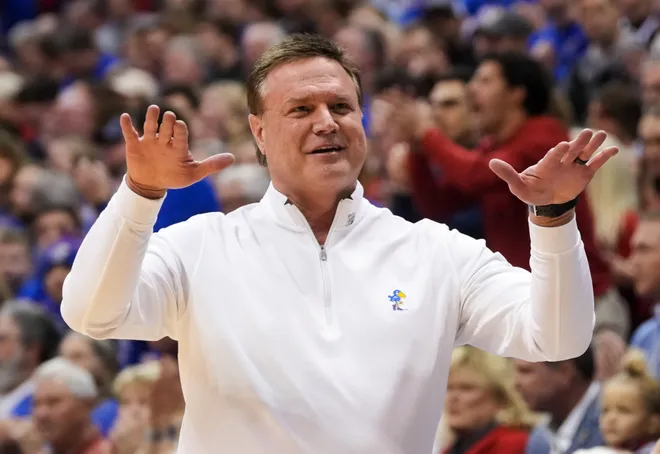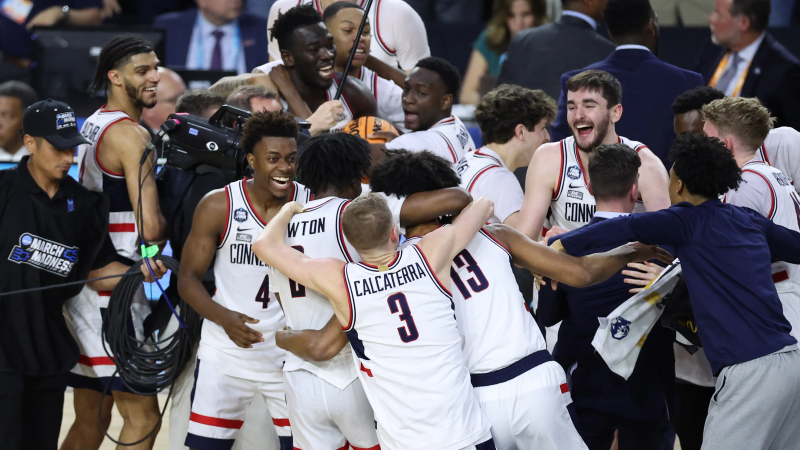Instead of embracing FBI's 'College Basketball Columbo,' NCAA should have faced reality
On Monday night, Kentucky football coach Mark Stoops went on his weekly radio show and responded to a caller who was upset about the Wildcats’ 51-13 loss to Georgia a couple of days earlier.
“I can promise you — Georgia, they bought some pretty good players,” Stoops said. “You're allowed to these days, and we could use some help. That's what they look like, you know what I mean, when you have 85 of ‘em. I encourage anybody that's disgruntled to pony up some more.”
A mere six years ago, as FBI agents were arresting basketball coaches with the entire NCAA world cheering them on, a college coach publicly accusing a program in his conference of buying players would have been the biggest story in sports. In 2023, it’s little more than low-grade bait for online engagement.
It would have been useful back in 2017 for the NCAA to use the FBI investigation — which ended up with five people who worked in college basketball serving time in real prison for mostly doing what had been done in college basketball forever — as a moment of self-reflection.
Would a better future for college sports be represented by Stoops talking openly about the cost of doing business in this profession, or would it be William Sweeney swaggering out of the FBI’s New York Field Office and proclaiming: “We have your playbook.”
The NCAA leapt at the vision of Sweeney as a College Basketball Columbo. It still got the reality that pay-for-play was, is and always will be the unstoppable force that powers a multi-billion dollar industry.
On Wednesday, this slow-moving saga that began with the Sept. 27, 2017 arrests of 10 men with connections to eight college programs and Adidas finally, officially ended.
The outcome of the final case involving Kansas, the crown jewel of the Adidas family, had pretty well been telegraphed by the other cases that came across the desk of the IARP, an independent group of lawyers who were commissioned by the NCAA to rule on these complex cases.
Like the other schools whose cases came up over the last couple of years, Kansas and head coach Bill Self got off with minimal penalties, none of which will impact the big business of winning championships. In fact, the IARP downgraded every one of the initial allegations levied by the NCAA from Level 1 to Level 2 or 3.

It wasn’t just a slap in the face to the NCAA’s enforcement process, it was a complete repudiation of the investigative work that had characterized Adidas representatives as Kansas boosters and pinned a significant amount of responsibility on Self for knowing about and even encouraging Adidas to intervene on Kansas’ behalf in the recruitment of elite prospects. There was even a text exchange between Self and T.J. Gassnola, an Adidas “consultant” and youth coach, that looked like a smoking gun:
“In my mind, it’s KU, Bill Self. Everyone else fall into line. Too (expletive) bad,” Gassnola wrote. “That’s what’s right for Adidas basketball. And I know I am RIGHT. The more you have lottery picks and you happy. That’s how it should work in my mind.”
“That’s how ur (sic) works. At UNC and Duke,” Self replied.
“I promise you I got this," Gassnola replied. “I have never let you down. Except (Deandre Ayton, who went to Arizona) lol. We will get it right.”
Anyone who understands the underbelly of college basketball could have immediately interpreted that exchange for exactly what it likely was: Gassnola, who testified in 2018 that he had paid Ayton’s mother $15,000 to grease the skids, promising to be the bag man for other top prospects Self might want.
But fortunately for Kansas and other schools that went through the IARP process, the panelists did not, in fact, have any understanding of how college sports actually work.
In one instance in the IARP’s 162-page report, it said that there was nothing unique in Kansas’ sponsorship agreement that would show Adidas’ motivation to elevate the Jayhawks above other Adidas schools.
In another, it dismissed the infamous Self-Gassnola text exchange, relying largely on Self telling them that it was a plainly understood inside joke. The IARP bought it because — and this is word-for-word in the report: “(Gassnola) punctuated the end of his text message with ‘lol,’ an abbreviation commonly understood to mean ‘laugh out loud.’ ”
And finally, even though the IARP did say there was enough evidence to characterize Gassnola as a booster, it did not find the same about Adidas employees Jim Gatto or Merl Code and the company overall, a stance which could only be explained if you believe Gassnola acted alone and had no coordination with the people at Adidas who actually had the money and the authority to go around paying players.
It's naive. It's nonsensical. It's actually quite insulting to anyone who has been in this world for any length of time.
And yet, the NCAA has only itself to blame for putting these cases in the hands of real lawyers who work in real courtrooms, thinking this would circumvent the holes in its infractions process. Instead, these people who are used to trying cases that require the kind of specific evidence necessary to make those connections took one look at how NCAA justice works and pretty much laughed.
And so Kansas got off pretty easy, just like LSU, NC State and even Louisville, which self-imposed a postseason ban in 2016 for a different scandal but did not have to pay compounding interest on this one.
Arizona self-imposed a postseason ban eight games into the 2020-21 season, which in retrospect might have been unnecessary. Of all the programs tied to the FBI investigation, the only one given a postseason ban — Oklahoma State — was the only one that went through the traditional NCAA infractions process rather than the IARP.
Christina Guerola Sarchio, a highly-decorated Washington, D.C. attorney who led the panel on Kansas, was asked Wednesday about the IARP’s legacy now that its work is shutting down.
She declined to answer.
To be clear, it was always silly that the Self-Gassnola text exchange got into the NCAA’s hands only because the Feds put Gassnola on a witness stand. It's even sillier, and in some ways quite tragic, that otherwise normal people like Jim Gatto and Merl Code, who did marketing work for a shoe company, went to federal prison for these so-called crimes, while the coaches they helped completely turned their backs on them.
But what happened, and what was discovered, were clearly against the NCAA rules that for decades served as a veneer of purity, helping turn people like Self into God-like figures and multi-millionaires.
Is there a moral difference between what Stoops referred to on the radio and what Adidas was doing for Kansas? Not really. The biggest change is that it was against the rules then and is more or less within the rules now. Whether you believe the old system or the new one is better is up to each individual. But it never goes backward. Never.
Not long after the FBI started rounding up coaches, then-NCAA president Mark Emmert appointed a special commission to bring integrity back to college basketball. Accomplished people like former Secretary of State Condoleezza Rice, retired Army General Martin Dempsey, former White House Counsel Kathy Ruemmler and Grant Hill were eager to help, along with the typical array of college presidents and athletics administrators.
“Transformative changes are necessary, but the goal should not be to turn college basketball into another professional league,” its final report stated. One by one, their recommendations, like the creation of the IARP, have either been rolled back or completely forgotten. They were, in the end, an irrelevance against the market forces that led to athletes being allowed to profit off their name, image and likeness. When there’s this much money to be made in a sport, some of it is always going to flow downhill.
Had the NCAA been realistic about its predicament back then, it would have saved a lot of time and angst and might have even had a better plan to move forward than begging Congress for help. But that effort is probably going to feel a lot like the story of the IARP: A lot of bluster and effort in service of an unwinnable fight.

Disclaimer: The copyright of this article belongs to the original author. Reposting this article is solely for the purpose of information dissemination and does not constitute any investment advice. If there is any infringement, please contact us immediately. We will make corrections or deletions as necessary. Thank you.







